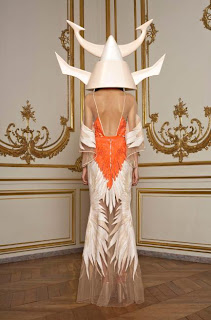where do i begin..........
I define art the way I define creativity... it's a creative work, it has to be built...
we were looking at chuck close - the sum of all these parts, boxes, that creats this image, that does this thing to you... taking these peices, adding the human sprit that does something more.... it's something of him in it... it's onoble, valuable... the whole post modern movement - nothing matters... it's like destruction... like a vat of paint... not only am I not creating something- i'm honering the element of destruction rather than creating
she's saying nothing matters...
Abby: why is she saying that
Courntey: it's something you can avoid
Matt: you can't ecape it
you can deflect it... you're forced to wathc...
part of you goes, I don't want to watch - but you do.... it's the point of her work..
is this errotic, is this offensive??? do
Courntey: it's like the woman with the box allowing men to grope her - and later they get how wrong it is.
it's about the conflict
Matt: it's asulting the viewer.... i was interested and looked and now I feel ashamed that I looked. She gave this fertility thing
Abby: i think she filmed this in serbia... she got the concept... i believe it's real and not filmed
Marhia: I think it's offensive that people find it offensive. why is bearing her breasts wrong, it was her choice... shes comfortable with her body
Matt: I felt concerned for her - what would make you want to do this? not just expose yourself, but to make you want to use your body to assult people who go by?
Marhia: why is it anassult?
Abby: that's really unfair.. her body is her work, but you see art photos, sculptures, all of women's breasts - and there is no problem with it.. it might be the element of time - that it's video
Matt: it's the statement... not her breasts
Cortney: what if the statement is i like my body ?
Abby: I think it's degrading to say that you are worried about her. She'san artist she's choosing what to do... her body is her canvas... you're not giving her enough credit as an intellectual and a choice
Cortney: she cast herself. it's not like it's someone else
Matt: I know she wants to - but my concern about it - i feel like art should be building up - rather than taking it appart.
it feels like the statement doesn't really matter
I don't have anything to hide.. modesty doesn't matter
Marhia: is it the lack of modesty that offends you, or is it the statement
Matt: it's like the same statement - the creation process doesn't matter
Abby: I'm not clear on what shes destroying
Courtnet: she's destroying societies expectations that women should stay covered up
Abby: in Serbia - there are topless beaches
Cornty: but shes showing it in america
Marhia: but why are breasts always sexual
Jeff: it's more of an informative piece -it's a freedome of expression, if she hadn't allowed herself to do it in a museum - showing the actula act - is the art
Matt: so is any expression art?
I think there aresome that don't
her point was to make me drawn it.....
and then to turn it around "ha you looked
Jeff: i think it's the conflict of one's self. I haven't seen it, - but knowing about it - now i see it as informative not sexy
Abby: it is kinda sexy
Matt: in an american gallery - it does feel sexy
cultural
MArhia: but why should it just make men feel uncomfortable? I apprecaited the sexieness of it - but I don't feel like i should feel bad about it. WHy is America so worked up about Sex? everyone has it
Matt: but she's definitely trying to make the viewer uncomforatble. I see that as low art... I can take a photo that is offensive nad graphic... but vs. chuck close - hours and hours of work..
Marhiia: she's tearing someting down?
Matt: socoal constructs and sexuality
Abby: Yes please - could we please tear those things down?
Coruntery; i think the only thing that bothered me is that it was in public, and that people could judge me
Abby: what would you think if this was an actual live performance????
she does preform live?
Matt: just because it's a video...
the medium makes it art
Marhia: i think it's mocking media
cournty: she had some dramatic angles
Abby: I think she's more dedicated to art than other artists, she's almost died doing some of her performances, she walked the wall of china, and walked and met in the middle, and then broke up..
this is such a great discussion
Abby:
what is art???
is it an instense life????
I have the balls to make a painting, but not the guts to do what this woman does
Marhiha: i think this is what she wanted
Matt; I feel the way that I define art -
chloe: activism for arts sake
Abby: she's not a young woman anymore.. it's not like she was an 18 year old porn star
chloe: a lot of art that is more activiim - a statement to be a statement....
Jeff: like graphitii?
Chloe: but if it's activiskm like tags
like Banski does art and then there are people who do gang stuff and swwear words and
















 Just a couple different art pieces that I like ^_^
Just a couple different art pieces that I like ^_^




 Untitled (joke)
Untitled (joke)